Photo wallpaper in the interior of the kitchen: original ideas and solutions

An obligatory attribute of any modern design is not only beauty and practicality, but also, if possible, originality. Giving preference to standard solutions such as plaster, tiles or simple wallpaper, we run the risk of decorating the kitchen, albeit pretty, but without a twist - this is unlikely to be remembered by sophisticated guests. Wall murals will be a good solution for making the interior unique.
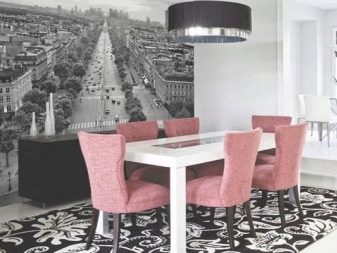
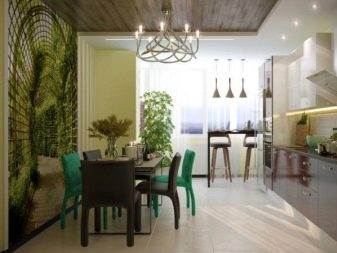
Peculiarities
The mass fashion for wallpaper appeared in the last decades of the USSR, since then the very fact of buying such finishing materials testified to the mass of the owner's virtues, including good artistic taste and a certain status in society. At the same time, the variety was extremely small - the wallpaper was printed serially, literally a few options were offered to choose from, so very quickly the design of the apartments began to repeat itself, and the photo wallpaper turned into bad manners, almost disappearing from sale at the end of the last century. By the way, no one dared to glue them in the kitchen at that time - they were usually made from plain paper, which would quickly become unusable in kitchen conditions.
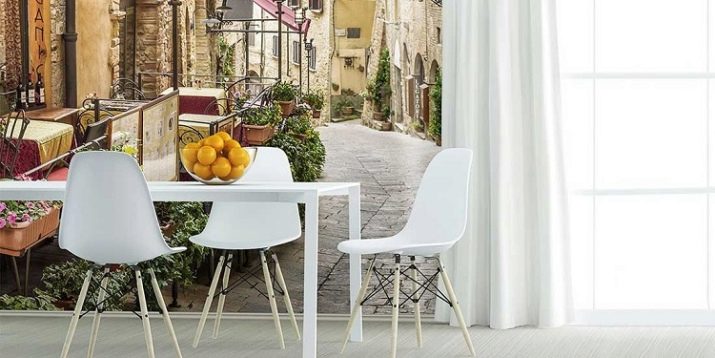
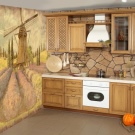
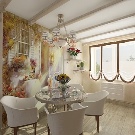
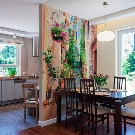
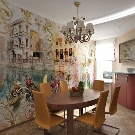
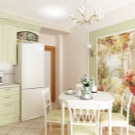
Photo wallpapers have reached a completely new level in the last 10-15 years, together with the rapid development of printing technologies. Modern technologies make it possible to embody any design ideas, since now the client can apply any drawing of sufficient resolution to the coating. In fact, on the wallpaper, you can even depict yourself against the background of a beautiful landscape, or simply use any picture that is full on the Internet, turning it into a wall of your own kitchen.
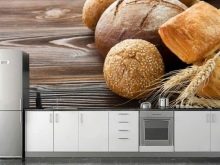
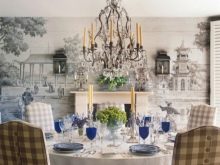
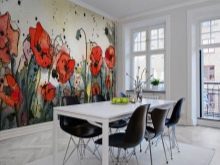
At the same time, the wallpaper became much more resistant to various influences, thanks to which, finally, they found themselves in the interior of the kitchen. They began to be produced with special protective coatings, thanks to which they no longer lose their original appearance in case of accidental ingress of a small amount of water, and even allow cleaning with a wet rag. True, when choosing wallpaper specifically for the kitchen, this point should be clarified, since inexpensive options are usually still made from plain paper.

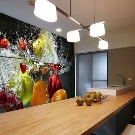
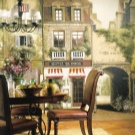
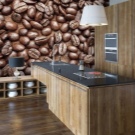
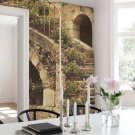
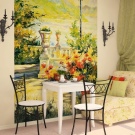
Whichever type the selected wallpaper belongs to, in the kitchen, there are still places where gluing them is considered inappropriate... First of all, this, of course, is the apron, as well as the areas adjacent to it - it is here that there is an increased amount of moisture and steam, as well as high temperature, and sometimes even sparks. Under the constant influence of destructive factors, even a wallpaper-like finish protected from them will not last long, and may also cause a fire.
For this reason, the main place in the kitchen where using photo wallpaper makes sense is on the opposite wall from the one with the sink and stove. It is not customary to decorate the entire kitchen, or most of it, with this material, but there is no need for this - it is always used as an accent, which means it should not occupy more than one wall or corner.
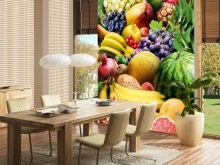

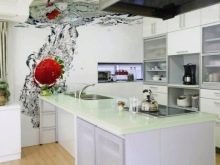
Views
The modern classification of photowall-paper is very extensive, therefore, some of the characteristics below can be combined in one roll without contradicting each other. According to the specifics of the surface, it is customary to divide photowall-paper into two varieties.
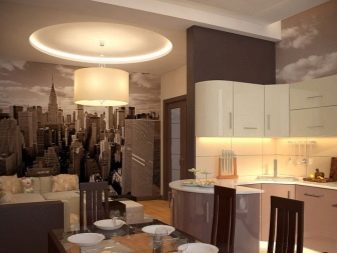
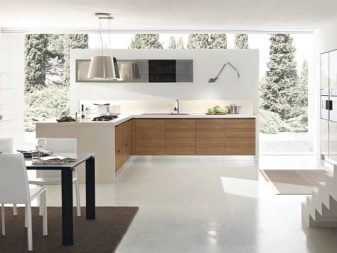
- Smooth. They are quite reminiscent of any other wallpaper made of paper or non-woven, since their surface is perfectly flat - provided that the wall under them does not have protrusions and depressions.Such wallpapers are relatively cheap, they may have an outer protective layer that is resistant to water, but the wall must be perfectly flat before gluing them, otherwise the effect will be doubtful.
- Textural. Such wallpapers do not have a smooth surface - on the contrary, they can imitate the specificity of the surface of what is depicted on them. For example, you can often find imitation of painted canvas, sand, leather, and so on. Such a relief of the surface allows you to smooth out small irregularities in the wall, and also adds charm and believability in the 3D style, but the cost of such wallpaper in good performance is much higher.
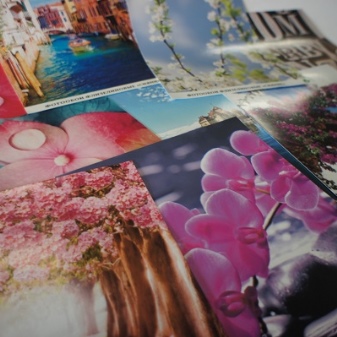
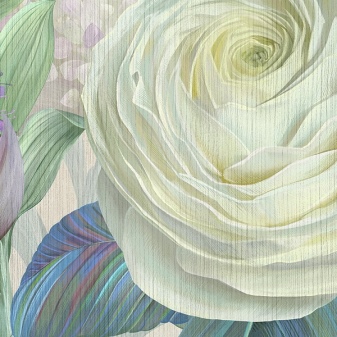
Most photo wallpapers assume a traditional gluing scheme - first you need to grease them or the wall with special glue, and then glue them. To simplify the task for self-gluing, you can also find self-adhesive goods from which you just need to peel off the protective film by opening the adhesive layer. In most cases, such a finish can be peeled off for a short time after gluing in order to correct the inconsistencies that have arisen during the repair process.
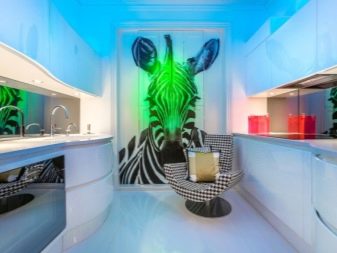

In addition to two-dimensional classic photowall-paper, canvases with 3D effect are also produced. In spacious, well-lit rooms, the continuation of space instead of a wall seems quite real, allowing at least to play with the perception of the kitchen area.
When using different landscapes, you can try to achieve the maximum effect of presence, which will cost a pretty penny, but can become an endless source of inspiration.
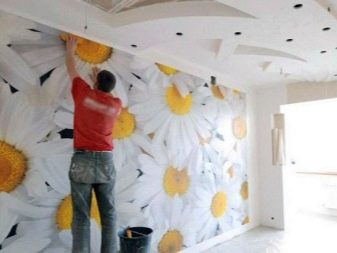

Finally, photo wallpaper can be made from different materials, and although the variety here is not as great as that of ordinary wallpaper, yet each variety has its own specifics. It is worth considering the main types of raw materials for the production of such finishes.
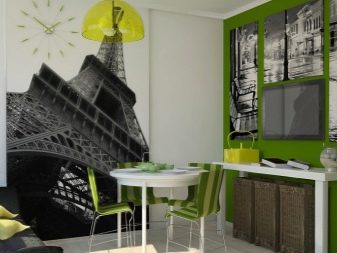
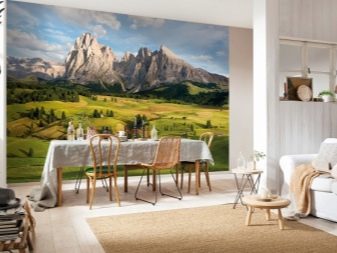
- Paper. Paper wallpapers are the simplest, therefore the cheapest, but their durability is minimal, as is the ability to withstand various threats. Even in living rooms, they are recommended to be glued only if the next repair is planned for the next few years, and there is no place for them in the kitchen.
- Non-woven In terms of the raw materials used, non-woven wallpaper is similar to paper, but in a highly improved form. Here you should carefully study the proposed sample of the product, since one roll may practically not differ from its paper counterpart, and the other is supplied with protection from moisture, is characterized by increased strength and the ability to pass moisture, preventing the occurrence of fungus. In the second version, such a solution can still be used in the kitchen, given its environmental friendliness, but you should make sure that the wallpaper is moisture resistant, and glue them only away from the working area.
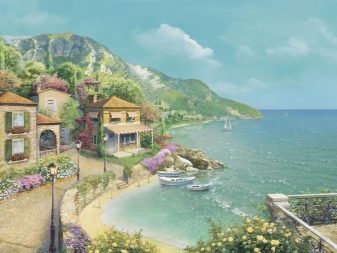
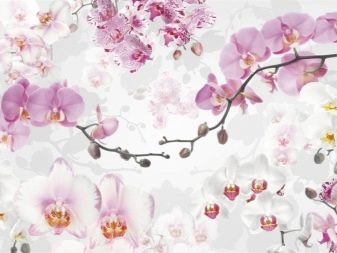
- Vinyl. Vinyl wall murals are perhaps the most reliable and durable solution for the kitchen, since they are not afraid not only of water, but (in their best examples) even cleaning "chemistry". Such a finish does not lose either its shape or color over time, but it is quite expensive, and it is also periodically criticized for its dubious chemical composition.
- Textile. Fabric wall murals do not always perfectly accurately convey the clarity of the photo and are distinguished by a well-visible texture, moreover, they are quite expensive, but they create a special atmosphere of comfort, for which they are appreciated. It is this solution that seems to be the most original of all, but one should be prepared for the fact that dust can intensively accumulate in the decoration, while not every fabric is well suited to water ingress or, moreover, the use of cleaning agents.
Finally, any material for the manufacture of photowall-paper is used both in one layer (simplex) and in two (duplex). Double-layer wallpaper is always thicker, stronger and more reliable, although this does not affect the degree of protection from the same moisture. Moreover, each layer can be made of a different material, which expands the operational characteristics of the product.
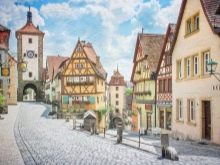
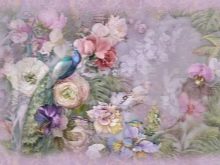
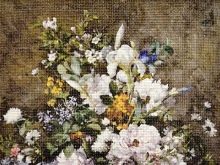
Plot selection
Since today absolutely any picture can become a subject for photowall-paper, the customer is unlimited in catalogs - he can achieve the complete uniqueness of his kitchen thanks to the printout of his project. This is good for uniqueness, but it complicates the task of choice - many people simply run their eyes from the abundance of possible solutions. Of course, for the kitchen it is better to choose something that awakens the appetite, or at least does not contradict it. Since there are an abundance of available kitchen wall design options, we will try to systematize the most popular subjects and present some simple classification of popular images.
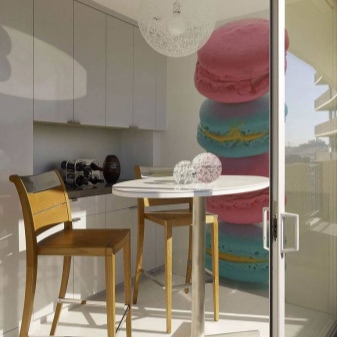
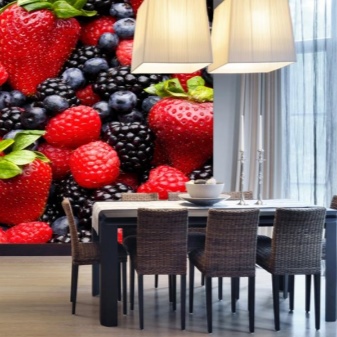
- Urban landscapes. This option cannot yet be called a leader, but it is rapidly gaining popularity - people do not want to eat at home, preferring to mentally transfer themselves to a cafe somewhere on the other end of the earth. This is a great option for dreamy people and travelers, and everyone chooses the exact location to their liking. Fans of metropolitan areas will like the view of some New York from a height, romantic nature will appreciate the narrow streets of Paris, while someone will find the pastoral landscapes of Provence more charming.
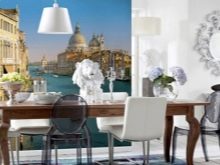
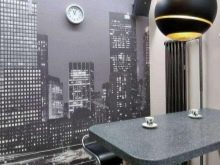
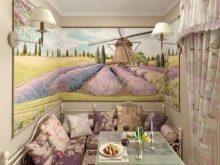
- Natural landscapes. This theme is chosen, guided by approximately the same arguments as in the case of urban landscapes. Thanks to these wallpapers, you can regularly dine on the seaside (the most popular option), but if you prefer mountains, you can choose this design as well.
The main thing is to find a landscape that would inspire, lift your spirits, and therefore increase your appetite.

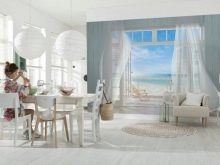

- Flowers and fruits. Few things whet your appetite more than a large image of juicy fruit, and flowers, while inedible, usually do not interfere with food intake either. Most often, the depicted object is presented in the form of macro photography, that is, the conditional tulips depicted on the wall look much larger than the real ones. In the vast majority of cases, a photographic image of the selected object is taken as a basis, but sometimes a drawn picture is also appropriate - the same oranges and limes, even in this form, can stimulate the desire for a snack.
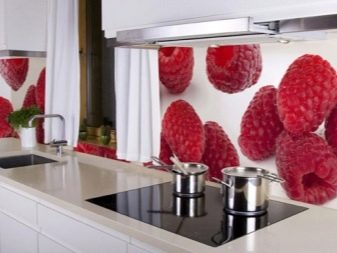
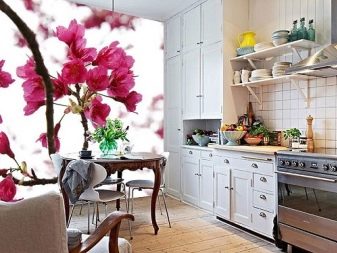
- Animals. Of all the solutions described above, this is perhaps the least common, because it does not have obvious ties to the kitchen. Nevertheless, a good mood and good mood are important for a good appetite. If you know that you like a certain animal and can easily improve your appetite, you can choose its image as a subject for kitchen photo wallpaper. Fauna is often depicted in natural habitat, which makes this decoration a natural landscape.

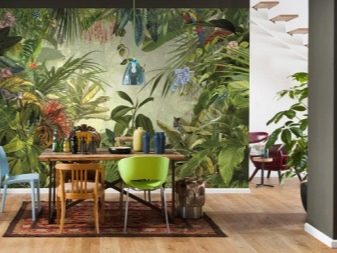
Interesting combinations
It is important not only to choose an interesting subject for photo wallpaper and their high-quality variety, but also to make sure that such an accent goes well with the rest of the kitchen decoration and its overall design. This is exactly the case when the dry theory is not always unconditionally clear, so let's move on to illustrative examples.
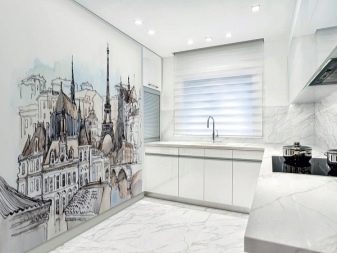

The first example clearly shows that wall murals should always fit into the design of the room - although they are the main focus, this does not always mean that they should fundamentally stand out from the color scheme. This kitchen, which is a somewhat strange mix of a semblance of rustic style and austere loft, may seem too gray and colorless to many, but if the photo wallpaper on the far wall were colored, this impression would be further exacerbated. Black and white, but still pretty beautiful wallpaper allows you to revive the interior a little, without even giving up the gray scale that is beloved by the owner.
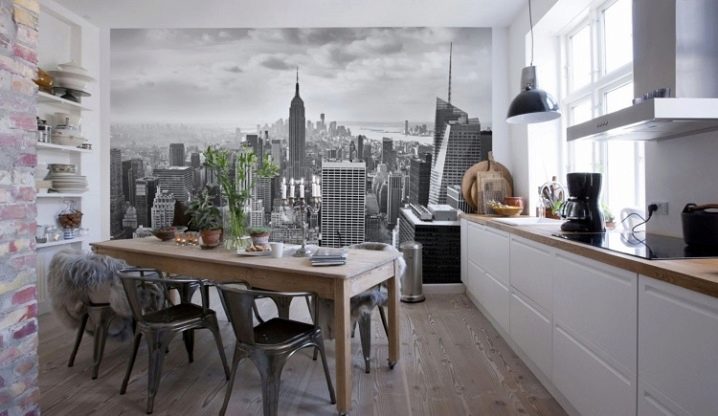
Of course, more often customers still try to fully reveal the capabilities of photo wallpapers, and this requires full color. To create comfort, in the overwhelming majority of cases, warm colors are used, which is why even green spaces that are not related to food are popular in kitchens.Agree, the wallpaper on the second photo definitely does not spoil your appetite, and it can also inspire you to overcome the problems of a new day.
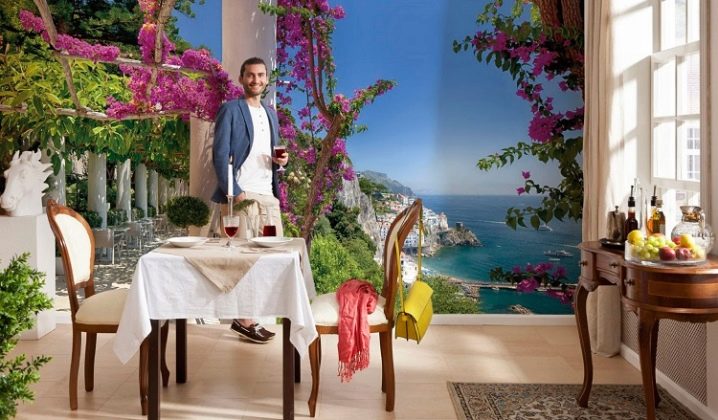
At the same time, modern photowall-paper is good because here the conditions are completely dictated by the customer. In his wishes, he is free to go far beyond the generally accepted norms. Previously, if your tastes were very different from popular solutions, you would not find anything worthwhile, but now no one bothers you to order not only black and white wallpaper, but also finishing in cold colors. If you really dine by candlelight with their living fire, then even the cold example number three can turn out to be unexpectedly cozy, and most importantly - original.
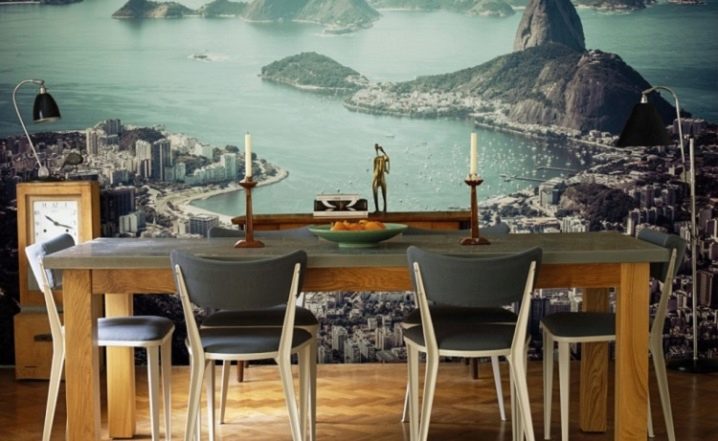
After all, there is room for even abstraction or thoughtful art on kitchen wall murals. It is enough to look at the next example - here both chocolate and milk are presented in the form of elements, which is why you just want to taste them. The substances are depicted for a reason - they at the same time take the form of horses, to which the owner of the kitchen, apparently, has an addiction. By the way, in this photo you can clearly see how the accent in the form of photo wallpaper, not differing much from the general gamut of the room, can simultaneously stand out and harmonize with it.
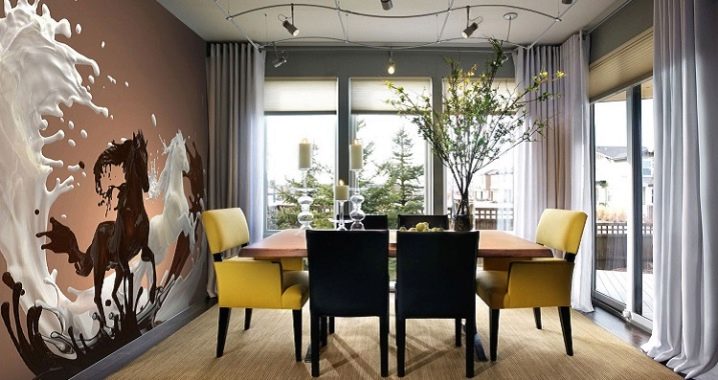
Finally, it should be understood that wallpaper, like any other accent, does not have to cover the entire surface of the wall. Although the area covered with photowall-paper is never compressed to the size of the picture, it may well imitate a panel, making it possible for another finish on the same wall to form a conditional frame.
This frame, by the way, can imitate the frame of a real painting, or the borders of a niche recessed into the wall and decorated with a typical Italian landscape, as shown in the following photo example, can act as such.
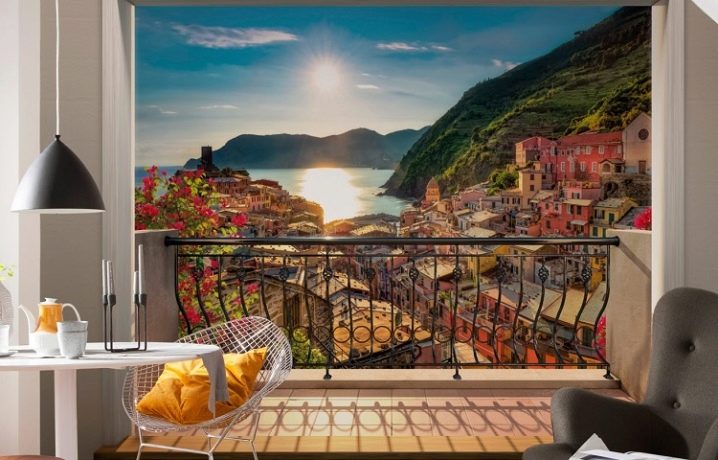
How to choose the right 3D wallpaper for the kitchen, see the next video.













The comment was sent successfully.